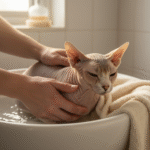Discover how to take care of a puppy with tips on preparing your home, feeding, vaccinations, training, grooming, safety, and more.
The day you Bringing Home a Puppy is monumental, but the most successful transitions begin long before your new companion crosses the threshold. Preparation isn’t just about buying toys; it’s about establishing a secure, nurturing, and predictable environment. This stage requires methodical planning to ensure your puppy feels safe and you feel confident.
Preparing Your Home: Creating a Safe Haven
Your home, a place of comfort for you, can be a labyrinth of hazards for a curious puppy. Dedicate time to a thorough, “puppy-proof” inspection. Are electrical cords neatly tucked away or covered? Have you secured or removed all small objects, chemicals, and toxic plants (like lilies or sago palms) from accessible areas? Think low—everything at nose and mouth level is fair game. Establish a dedicated “safe zone” or den, perhaps a crate or playpen, where your puppy can retreat when overwhelmed. This space should be comfortable, quiet, and consistently available. When Bringing Home a Puppy, remember that a prepared home drastically reduces stress and the risk of injury.
Establishing a Routine: Predictability is Comfort
Puppies thrive on predictability. Before your puppy arrives, create a basic daily schedule that details feeding times, potty breaks, exercise, and sleep. This isn’t just for your organization; it’s the cornerstone of successful house training and behavioral stability. An established routine simplifies the demanding first few weeks, giving your puppy a clear understanding of what happens when. This structure is critical when Bringing Home a Puppy and integrating them into your life.
Nurturing Health and Growth: Feeding, Care, and Wellness
A puppy’s rapid development demands meticulous attention to health, nutrition, and early medical care. These choices lay the foundation for a lifetime of wellness.
Feeding and Nutrition: Fueling Rapid Growth
Proper nutrition is non-negotiable. Consult with the breeder or rescue organization about the specific food your puppy currently eats and plan to keep them on it for the first few weeks to avoid digestive upset. Any changes should be gradual. Choose a high-quality, age-appropriate commercial puppy food formulated for your dog’s expected adult size (small, medium, or large/giant breed). Overfeeding can be as harmful as underfeeding, so follow the guidelines on the food packaging and consult your veterinarian. Consistency in feeding times, as established in your routine, aids in digestion and predictable house training schedules.
Healthcare & Vaccinations: Proactive Protection
Immediately upon Bringing Home a Puppy, schedule an initial veterinary check-up. The vet will establish a wellness plan, which is crucial for early detection of potential issues. Your puppy will need a series of core vaccinations (like Distemper, Parvovirus, and Adenovirus) and likely a Rabies vaccine. They also require deworming treatments. Do not skip these appointments. Parasite prevention (flea, tick, and heartworm) should also begin early. Keep detailed records of all treatments and schedule necessary spaying or neutering discussions with your vet. Proactive healthcare is the best insurance for a long, healthy life.
Building Character: Training, Socialization, and Exercise
The period immediately following Bringing Home a Puppy is the most critical for shaping their adult behavior. This is when you teach them how to navigate the human world confidently.
Training & Socialization: The Foundation of Good Behavior
The period from roughly 3 to 16 weeks, known as the “socialization window,” is crucial. During this time, introduce your puppy to a wide variety of people (different ages, appearances), sights, sounds, and safe, vaccinated adult dogs. This exposure prevents future fear-based aggression and anxiety. Keep these experiences positive and short. Simultaneously, start basic obedience training immediately. Use positive reinforcement—rewards, praise, and treats—to teach commands like “Sit,” “Stay,” “Come,” and “Down.” Consistency is the secret weapon in training; everyone in the household must use the same commands and hand signals.
Exercise & Play: Burning Energy Constructively
Puppies have enormous energy, but their bones and joints are still developing. Exercise should be appropriate: multiple short play sessions and walks are better than one long, strenuous run. Focus on mentally stimulating play, like puzzle toys and fetch, as much as physical activity. Play strengthens your bond and helps prevent destructive behaviors that stem from boredom. When Bringing Home a Puppy, effective exercise means a well-behaved puppy.
Maintaining Appearance and Comfort: Grooming and Hygiene
Grooming & Hygiene: A Lifetime of Maintenance
Early introduction to grooming makes a lifetime of maintenance easier. Habituate your puppy to having their paws handled, their ears cleaned, and their nails trimmed. Start with short, positive sessions. Brushing, even for short-haired breeds, helps manage shedding and allows you to check for lumps, bumps, or parasites. Regular bathing using dog-specific shampoo maintains skin health. Dental hygiene is often overlooked; starting a routine of brushing your puppy’s teeth now will protect them from serious dental disease later.
The Emotional Component: Safety, Love, and Bonding
Safety & Identification: Ensuring Their Return
A microchip is essential. Once Bringing Home a Puppy, schedule an appointment to have a microchip inserted and ensure your contact information is up-to-date in the registry. Your puppy should wear a collar with an ID tag displaying your name and phone number at all times. This simple step is the quickest way to reunite you should they ever wander off.
Love & Bonding: The Heart of the Relationship
The most important task is to establish a loving, trusting bond. This happens through consistent, positive interactions—cuddling, gentle play, hand-feeding, and training. Be patient and understand that mistakes will happen. Your calm, reassuring presence is what your puppy needs most as they adjust to their new life.
Common Mistakes to Avoid When Bringing Home a Puppy
Even the most prepared new owners can make missteps. Avoid these common pitfalls:
- Too Much Freedom, Too Soon: Giving a puppy unrestricted access to the entire house before they are reliably house-trained is a recipe for accidents and destructive behavior. Use crates and playpens appropriately.
- Punishment-Based Training: Never yell at or physically punish your puppy, especially for accidents. This only teaches them to fear you and hide their actions. Focus exclusively on rewarding the behavior you want.
- Inconsistent Routine: Changing feeding times, walking times, or rules frequently confuses the puppy and delays training success.
4. Neglecting Socialization: Believing that a lack of exposure will keep them safer or “nicer” is detrimental. Under-socialized dogs often develop serious anxiety or aggression issues.
By actively focusing on these ten critical areas—from physical preparation and health to training and emotional bonding—you are not just surviving the first few weeks; you are confidently setting your puppy up for a happy, well-adjusted life. Bringing Home a Puppy is a huge commitment, but with this blueprint, you are ready for success.
FAQ Section Calculations
Answering Your Biggest Questions About Bringing Home a Puppy
- How long does it take for a puppy to adjust to a new home?
Most puppies begin to show signs of adjustment within the first two weeks, but it can take up to three months for a puppy to feel completely secure and integrated into a new home and routine. Be patient, consistent, and prioritize predictable schedules.
- How often should a puppy be fed?
Generally, puppies under six months of age should be fed three times a day (morning, noon, and evening). After six months, most owners transition to twice-daily feeding. Always consult your vet or the food packaging for exact serving sizes based on age and weight.
- What is the most important thing to teach my puppy first?
The single most important skill is to teach your puppy to love their name and to “Come” when called. This is a critical safety command. Simultaneously, focus on crate training and house-training, as these establish boundaries and hygiene habits immediately.
- How much sleep does a puppy need?
Puppies are major sleepers! They typically need between 18 and 20 hours of sleep per day, often in short naps throughout the day and longer periods at night. Providing a comfortable, quiet den (crate) encourages healthy sleep habits.











